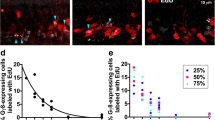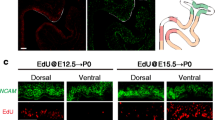Abstract
The bHLH transcription factor Olig2 is required for sequential cell fate determination of both motor neurons and oligodendrocytes and for progenitor proliferation in the central nervous system. However, the role of Olig2 in peripheral sensory neurogenesis remains unknown. We report that Olig2 is transiently expressed in the newly differentiated olfactory sensory neurons (OSNs) and is down-regulated in the mature OSNs in mice from early gestation to adulthood. Genetic fate mapping demonstrates that Olig2-expressing cells solely give rise to OSNs in the peripheral olfactory system. Olig2 depletion does not affect the proliferation of peripheral olfactory progenitors and the fate determination of OSNs, sustentacular cells, and the olfactory ensheathing cells. However, the terminal differentiation and maturation of OSNs are compromised in either Olig2 single or Olig1/Olig2 double knockout mice, associated with significantly diminished expression of multiple OSN maturation and odorant signaling genes, including Omp, Gnal, Adcy3, and Olfr15. We further demonstrate that Olig2 binds to the E-box in the Omp promoter region to regulate its expression. Taken together, our results reveal a distinctly novel function of Olig2 in the periphery nervous system to regulate the terminal differentiation and maturation of olfactory sensory neurons.









Similar content being viewed by others
Change history
22 June 2021
A Correction to this paper has been published: https://doi.org/10.1007/s00018-021-03870-2
References
Kageyama R, Ohtsuka T, Hatakeyama J, Ohsawa R (2005) Roles of bHLH genes in neural stem cell differentiation. Exp Cell Res 306(2):343–348
Powell LM, Jarman AP (2008) Context dependence of proneural bHLH proteins. Curr Opin Genet Dev 18(5):411–417
Murdoch B, Roskams AJ (2007) Olfactory epithelium progenitors: insights from transgenic mice and in vitro biology. J Mol Histol 38(6):581–599
Sammeta N, Yu TT, Bose SC, McClintock TS (2007) Mouse olfactory sensory neurons express 10,000 genes. J Comp Neurol 502(6):1138–1156
Suzuki Y (2005) Expression of bHLH transcription factors and IGFs in the non-sensory patches, olfactory epithelium and vomeronasal organ. Chem Senses 30(Suppl 1):i125–i126
Cau E, Casarosa S, Guillemot F (2002) Mash1 and Ngn1 control distinct steps of determination and differentiation in the olfactory sensory neuron lineage. Development 129(8):1871–1880
Cau E, Gradwohl G, Casarosa S, Kageyama R, Guillemot F (2000) Hes genes regulate sequential stages of neurogenesis in the olfactory epithelium. Development 127(11):2323–2332
Rowitch DH, Lu QR, Kessaris N, Richardson WD (2002) An ‘oligarchy’ rules neural development. Trends Neurosci 25(8):417–422
Zhou Q, Anderson DJ (2002) The bHLH transcription factors OLIG2 and OLIG1 couple neuronal and glial subtype specification. Cell 109(1):61–73
Takebayashi H, Nabeshima Y, Yoshida S, Chisaka O, Ikenaka K, Nabeshima Y (2002) The basic helix–loop–helix factor olig2 is essential for the development of motoneuron and oligodendrocyte lineages. Curr Biol 12(13):1157–1163
Miyoshi G, Butt SJ, Takebayashi H, Fishell G (2007) Physiologically distinct temporal cohorts of cortical interneurons arise from telencephalic Olig2-expressing precursors. J Neurosci 27(29):7786–7798
Cai J, Chen Y, Cai WH, Hurlock EC, Wu H, Kernie SG et al (2007) A crucial role for Olig2 in white matter astrocyte development. Development 134(10):1887–1899
Sun Y, Meijer DH, Alberta JA, Mehta S, Kane MF, Tien AC et al (2011) Phosphorylation state of Olig2 regulates proliferation of neural progenitors. Neuron 69(5):906–917
Harrington EP, Zhao C, Fancy SP, Kaing S, Franklin RJ, Rowitch DH (2010) Oligodendrocyte PTEN is required for myelin and axonal integrity, not remyelination. Ann Neurol 68(5):703–716
Soriano P (1999) Generalized lacZ expression with the ROSA26 Cre reporter strain. Nat Genet 21(1):70–71
Wang YZ, Yamagami T, Gan Q, Wang Y, Zhao T, Hamad S et al (2011) Canonical Wnt signaling promotes the proliferation and neurogenesis of peripheral olfactory stem cells during postnatal development and adult regeneration. J Cell Sci 124(Pt 9):1553–1563
Zhao T, Gan Q, Stokes A, Lassiter RN, Wang Y, Chan J et al (2014) beta-catenin regulates Pax3 and Cdx2 for caudal neural tube closure and elongation. Development 141(1):148–157
Wang YP, Stokes A, Duan ZJ, Hui J, Xu Y, Chen YP et al (2016) LDL receptor-related protein 6 modulates Ret proto-oncogene signaling in renal development and cystic dysplasia. J Am Soc Nephrol 27(2):417–427
Song L, Li Y, Wang K, Wang YZ, Molotkov A, Gao L et al (2009) Lrp6-mediated canonical Wnt signaling is required for lip formation and fusion. Development 136(18):3161–3171
Gan Q, Lee A, Suzuki R, Yamagami T, Stokes A, Nguyen BC et al (2014) Pax6 mediates ss-catenin signaling for self-renewal and neurogenesis by neocortical radial glial stem cells. Stem Cells 32(1):45–58
Ligon KL, Fancy SP, Franklin RJ, Rowitch DH (2006) Olig gene function in CNS development and disease. Glia 54(1):1–10
Schwob JE, Jang W, Holbrook EH, Lin B, Herrick DB, Peterson JN et al (2017) Stem and progenitor cells of the mammalian olfactory epithelium: taking poietic license. J Comp Neurol 525(4):1034–1054
Ellis P, Fagan BM, Magness ST, Hutton S, Taranova O, Hayashi S et al (2004) SOX2, a persistent marker for multipotential neural stem cells derived from embryonic stem cells, the embryo or the adult. Dev Neurosci 26(2–4):148–165
Guo Z, Packard A, Krolewski RC, Harris MT, Manglapus GL, Schwob JE (2010) Expression of pax6 and sox2 in adult olfactory epithelium. J Comp Neurol 518(21):4395–4418
Chen Y, Miles DK, Hoang T, Shi J, Hurlock E, Kernie SG et al (2008) The basic helix–loop–helix transcription factor olig2 is critical for reactive astrocyte proliferation after cortical injury. J Neurosci 28(43):10983–10989
Wong ST, Trinh K, Hacker B, Chan GC, Lowe G, Gaggar A et al (2000) Disruption of the type III adenylyl cyclase gene leads to peripheral and behavioral anosmia in transgenic mice. Neuron 27(3):487–497
Belluscio L, Gold GH, Nemes A, Axel R (1998) Mice deficient in G(olf) are anosmic. Neuron 20(1):69–81
Kaneko-Goto T, Yoshihara S, Miyazaki H, Yoshihara Y (2008) BIG-2 mediates olfactory axon convergence to target glomeruli. Neuron 57(6):834–846
Cheng LE, Reed RR (2007) Zfp423/OAZ participates in a developmental switch during olfactory neurogenesis. Neuron 54(4):547–557
Kolterud A, Alenius M, Carlsson L, Bohm S (2004) The Lim homeobox gene Lhx2 is required for olfactory sensory neuron identity. Development 131(21):5319–5326
Macdonald JL, Verster A, Berndt A, Roskams AJ (2010) MBD2 and MeCP2 regulate distinct transitions in the stage-specific differentiation of olfactory receptor neurons. Mol Cell Neurosci 44(1):55–67
Tsai RY, Reed RR (1997) Cloning and functional characterization of Roaz, a zinc finger protein that interacts with O/E-1 to regulate gene expression: implications for olfactory neuronal development. J Neurosci 17(11):4159–4169
Lu QR, Sun T, Zhu Z, Ma N, Garcia M, Stiles CD et al (2002) Common developmental requirement for Olig function indicates a motor neuron/oligodendrocyte connection. Cell 109(1):75–86
Ligon KL, Huillard E, Mehta S, Kesari S, Liu H, Alberta JA et al (2007) Olig2-regulated lineage-restricted pathway controls replication competence in neural stem cells and malignant glioma. Neuron 53(4):503–517
Lee AC, He J, Ma M (2011) Olfactory marker protein is critical for functional maturation of olfactory sensory neurons and development of mother preference. J Neurosci 31(8):2974–2982
Rodriguez-Gil DJ, Bartel DL, Jaspers AW, Mobley AS, Imamura F, Greer CA (2015) Odorant receptors regulate the final glomerular coalescence of olfactory sensory neuron axons. Proc Natl Acad Sci USA 112(18):5821–5826
Takebayashi H, Yoshida S, Sugimori M, Kosako H, Kominami R, Nakafuku M et al (2000) Dynamic expression of basic helix–loop–helix Olig family members: implication of Olig2 in neuron and oligodendrocyte differentiation and identification of a new member, Olig3. Mech Dev 99(1–2):143–148
Boutin C, Hardt O, de Chevigny A, Core N, Goebbels S, Seidenfaden R et al (2010) NeuroD1 induces terminal neuronal differentiation in olfactory neurogenesis. Proc Natl Acad Sci USA 107(3):1201–1206
Jones DT, Reed RR (1989) Golf: an olfactory neuron specific-G protein involved in odorant signal transduction. Science 244(4906):790–795
Qiu L, LeBel RP, Storm DR, Chen X (2016) Type 3 adenylyl cyclase: a key enzyme mediating the cAMP signaling in neuronal cilia. Int J Physiol Pathophysiol Pharmacol 8(3):95–108
Meijer DH, Kane MF, Mehta S, Liu H, Harrington E, Taylor CM et al (2012) Separated at birth? The functional and molecular divergence of OLIG1 and OLIG2. Nat Rev Neurosci 13(12):819–831
Zhang X, Cai J, Klueber KM, Guo Z, Lu C, Qiu M et al (2005) Induction of oligodendrocytes from adult human olfactory epithelial-derived progenitors by transcription factors. Stem Cells 23(3):442–453
Zhang X, Cai J, Klueber KM, Guo Z, Lu C, Winstead WI et al (2006) Role of transcription factors in motoneuron differentiation of adult human olfactory neuroepithelial-derived progenitors. Stem Cells 24(2):434–442
Liu Z, Hu X, Cai J, Liu B, Peng X, Wegner M et al (2007) Induction of oligodendrocyte differentiation by Olig2 and Sox10: evidence for reciprocal interactions and dosage-dependent mechanisms. Dev Biol 302(2):683–693
Liberia T, Martin-Lopez E, Meller SJ, Greer CA (2019) Sequential maturation of olfactory sensory neurons in the mature olfactory epithelium. eNeuro. https://doi.org/10.1523/ENEURO.0266-19.2019
Acknowledgements
We are grateful to David J. Anderson (HHMI and Caltech) for providing the Olig1/Olig2 frozen embryos, Jordan Hui, Ben Palmer, Arjun Stokes, Huan Zhao, Taylor Imai, Rebecca Duncan, Yue Liu, Santosh Kumar, Saharul Islam, Sarwat Amina and the rest of Zhou lab members for technical assistance or general support. This work was partially supported by grants from the NIH (R01DE021696, R01DE026737 and R01NS102261 to C.J.Z.), the Shriners Hospitals for Children (86600 and 85105 to C.J.Z., and postdoctoral fellowships to Y.Z.W. and R.G.), and the National Science Foundation of China (31970907 to Y.Z.W.). Q.G. and T.Y. received postdoctoral fellowships from the California Institute for Regenerative Medicine (CIRM) Stem Cell Training Program.
Author information
Authors and Affiliations
Corresponding author
Additional information
Publisher's Note
Springer Nature remains neutral with regard to jurisdictional claims in published maps and institutional affiliations.
Rights and permissions
About this article
Cite this article
Wang, YZ., Fan, H., Ji, Y. et al. Olig2 regulates terminal differentiation and maturation of peripheral olfactory sensory neurons. Cell. Mol. Life Sci. 77, 3597–3609 (2020). https://doi.org/10.1007/s00018-019-03385-x
Received:
Revised:
Accepted:
Published:
Issue Date:
DOI: https://doi.org/10.1007/s00018-019-03385-x




